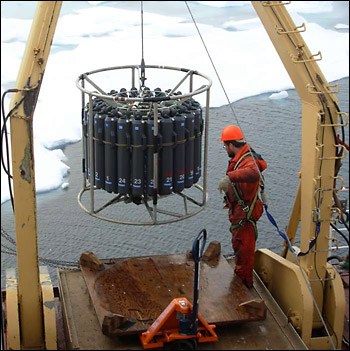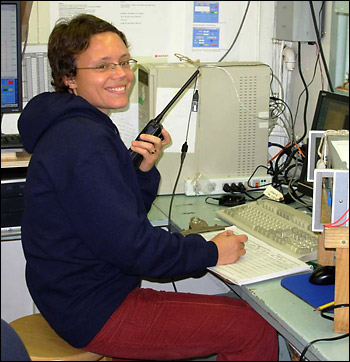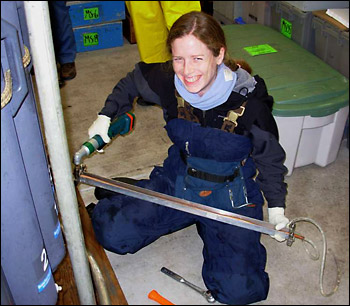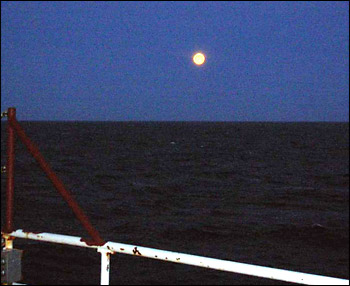Please note: You are viewing
the unstyled version of this website. Either your browser does not support CSS
(cascading style sheets) or it has been disabled. Skip
navigation.
Jennifer Jackson (University of British Columbia) and Abby Spieler (Lamont Doherty Earth Observatory)August 11, 2006
Although I took careful notes during the three daytime rosette casts, I'm still very nervous. With a gracious smile, Sarah Zimmerman, the chief scientist, has just stepped into the CTD lab to supervise the cast. The bridge, CTD deck and CTD lab communicate by radio and soon the rosette is lowered into the water. Hugh and Mike wait on the CTD deck, where it's warmer than usual, over an ice-free sea. They chat about the equipment and about past oceanographic escapades. While the rosette is in the water, at about 3 AM, the moon rises, shimmering pink and yellow over the black waves. Yesterday it was full; we will see one more full moon, on Thursday, September 7th, before this leg of the cruise is over. This is a shallow cast, down to 300 meters, since the water will be used only for particulate organic carbon, chlorophyll, total suspended solids and phytoplankton analyses. As the rosette descends, the CTD acquires measurements fifteen times a second of the salinity, temperature, dissolved oxygen, fluorescence and transmissivity, and these data are displayed graphically on the computer in the CTD lab. Sarah and I decide to trigger bottles at 9 different depths where the transmissometer and fluorometer show high levels of particles and chlorophyll in the water. Right at the surface, we observe a layer of fresh, warm water that is probably related to the MacKenzie River outflow, about 250 km to the south of our station. After the rosette comes back up to the surface and is rolled into the rosette shack, Mike and I, and Abby Spieler, another graduate student, check the Niskin bottles for integrity and proceed with the sampling. Meanwhile, our colleagues Jiuxin Shi and Yutian Jiao (Ocean University, China) are deploying a profiling reflectance radiometer on the forward deck. Soon it's time for a second rosette cast, which will go all the way to the bottom at 650 m, and I rush back to the CTD lab. By 4 am, the sun is rising again. When the rosette is safely back on deck, I leave the rosette shack to Hugh, Mike, Kristina Brown, Nes Sutherland and Abby as I hurry downstairs to pour 60L of newly sampled water though 0.7 micron filters. What a relief--both casts have gone smoothly! Last updated: October 7, 2019 | |||||||||||||||||||||
Copyright ©2007 Woods Hole Oceanographic Institution, All Rights Reserved, Privacy Policy. | |||||||||||||||||||||






